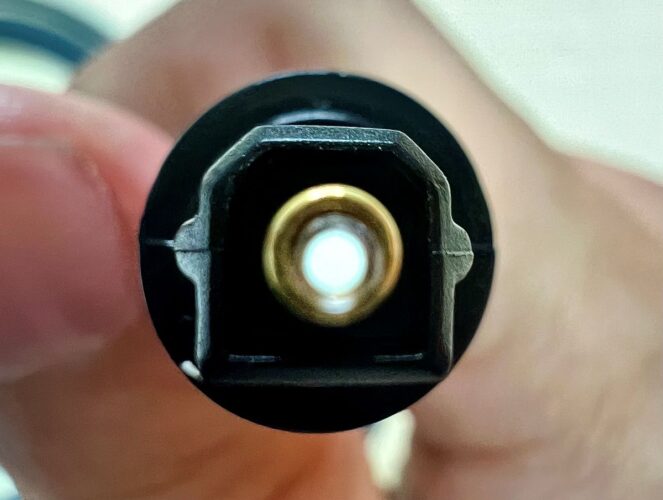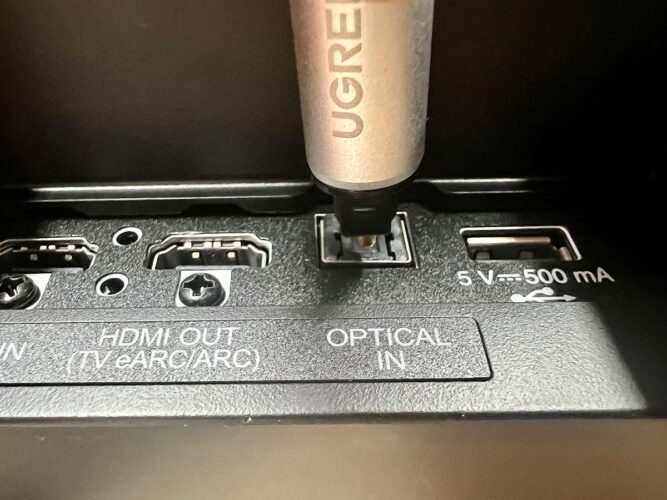Optical Cables Going Bad? 4 Key Signs & Their Root Causes

- An optical cable going bad might show symptoms like sound distortions, loose connections, visible damages, and the absence of a red indicator light.
- Mishandling, such as improper plugging, poor storage, and dirty connectors, can damage optical cables.
- Proper cable care includes gentle handling, correct unplugging, ensuring cleanliness, and storing in dry, UV-protected areas.
Are you puzzled about whether optical cables go bad or how to spot issues with your optical audio cable?
This guide breaks down simple ways to tell if an optical audio cable is acting up and shares easy-to-follow solutions that help you reserve your cable properly.
With advice from our experienced tech team, you’ll be set to pinpoint and address any hiccups.
Dive in and make sense of it all!
Quick Navigation
How To Know When an Audio Optical Cable Goes Bad (Symptoms)
Except for visible breakage, it’s hard to tell when a cable is bad. Hence, you should also learn to identify the non-visible signs that indicate it’s going bad.
If you can recognize its faults, you’re one step closer to fixing the issue. Below are symptoms of damage to look out for.

1. Loss of sound quality/signal
A loss of sound quality is the first sign that an audio optical cable has gone bad. The transmitted audio may become distorted, with crackling noises, dropouts, or intermittent sounds.
Your audio device (external speaker or soundbar) may also remain silent, showing a complete loss of audio signals. All these point to a low-quality, broken, or damaged cable.
2. Loose connections
Optical audio connectors include the cable’s plug and the Optical ports on your devices. If either connector is damaged, you may notice that your connection will become loose—the plug won’t fit snugly into the port.
Loose connections cause poor contact and signal loss, ultimately affecting audio quality.
3. Physical damage
Due to their production and jacket quality, some optical cables are fragile. Physical impacts like foot traffic and twisting can cause the cable to break.
Look out for physical signs of damage, like fraying or breakage along the length of the cable. These can affect or completely hinder the cable’s performance.
4. No red indicator light
Optical cables transmit data through light signals, so the plugs on both ends of the cable often have a red indicator light. When the red lights are on, it means the cable is connected properly.
If you have plugged in the cable properly, but the red light does not turn on at either end, it’s a sign that the cable is damaged or faulty.
Possible Mishandlings and Optical Cable Problems
Optical cables are vulnerable to impact forces like twisting, pulling, and crushing, which can alter their fiber component and affect audio transmission.
Now that you recognize signs of damage in optical cables, it’s time to learn what practices cause them harm.

1. Improper plugging and unplugging
There is a technique for plugging and unplugging optical audio cables. It’s a simple, straightforward process. You can damage or break the connectors by doing any of the following:
- Pulling on or wiggling the cable too hard.
- Using only one hand to grasp the connector while unplugging. You should use one hand to hold the device firmly, and the other to unplug the optical cable.
- Trying to plug in the cable without following its hexagon shape and aligning the connectors. You may damage the tip of the plug during the struggle and make it loose.
2. Poor storage
Twisting an optical audio cable into tight coils can break or fray the sheath. It can even break the optical fiber at the core of the cable.
Don’t store optical cables in places with unfavorable conditions like direct sunlight, excessive humidity, or cold. If their plugs are exposed, moisture and contaminants can enter and reach the core of the cable.
3. Dirty connectors
If there’s dust and debris on the optical audio connectors, the mating force will embed the particles onto the connectors, causing scratches and pits. This affects contact, disrupts transmission, and reduces signal quality.
How To Use and Reserve Your Optical Cable Properly
To prevent problems with audio-optical cables, it is vital to use and store them properly. Below are some useful tips:
- Always handle the cable gently. Don’t twist or bend it at sharp angles.
- Don’t pull on the cable at any point. To unplug, simply grasp the connector and pull it straight out of your device.
- Keep the cable’s connectors clean by replacing the plastic tips before storage. When necessary, clean the optical ports with a soft cloth.
- When it’s not in use, keep the cable in a loose coil and store it in a dry, UV-protected area (i.e., a room or box).
Conclusion
While HDMI is the current favorite connector for AV signals, optical audio cables are an excellent option if you want to transmit digital audio separately. Optical audio technology is from the 1980s, so it is still compatible with older media devices.
One significant advantage of optical cables is that they are immune to electromagnetic interference. However, they aren’t immune to physical interference and damage.
Physical force, improper connection, and poor storage practices can spoil your optical cable. We advise you to inspect it regularly and employ the preventive maintenance tips outlined in the article above.
Gabriella ‘Diogo is a technical writer with a vested interest in tech hardware and equipment. She shares her knowledge and processes in an easy-to-grasp, lighthearted style. When she’s not testing or researching device performance, you’ll find her writing short stories or rewatching episodes of her favorite sitcoms.



If i have a bad optical cable, can it make it sound like the left sound is coming to my right ear and vice versa ? i have a 2 pc setup where i run a digital optical cable from gaming pc to goxlr and all other sound is fine besides the gaming pc sound, right sound is in left ear and vice versa, and yes , headset is correctly on.
I have tested all my optical cables using a torch they all test out well.
When I assemble the wall plates and plug the tv in I have no sound at my sound bar. I’ve checked and have a bright red light at the wall plug behind the sound bar, when I plug the lead from the sound bar in the red light at the sound bar end is dull. Can the wall plug be misaligned slightly would that be a reason the light is dull and the sound bar isn’t working?